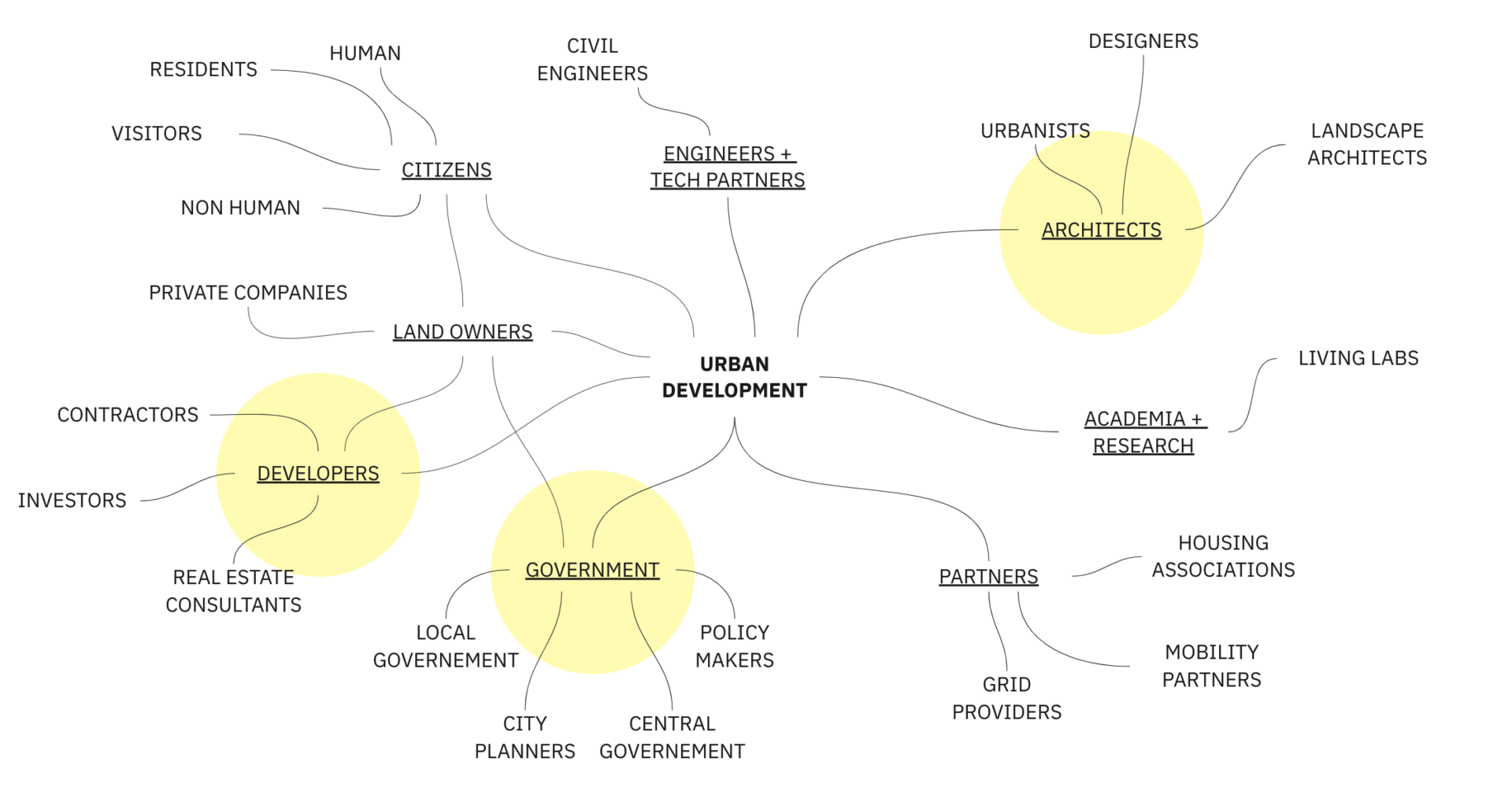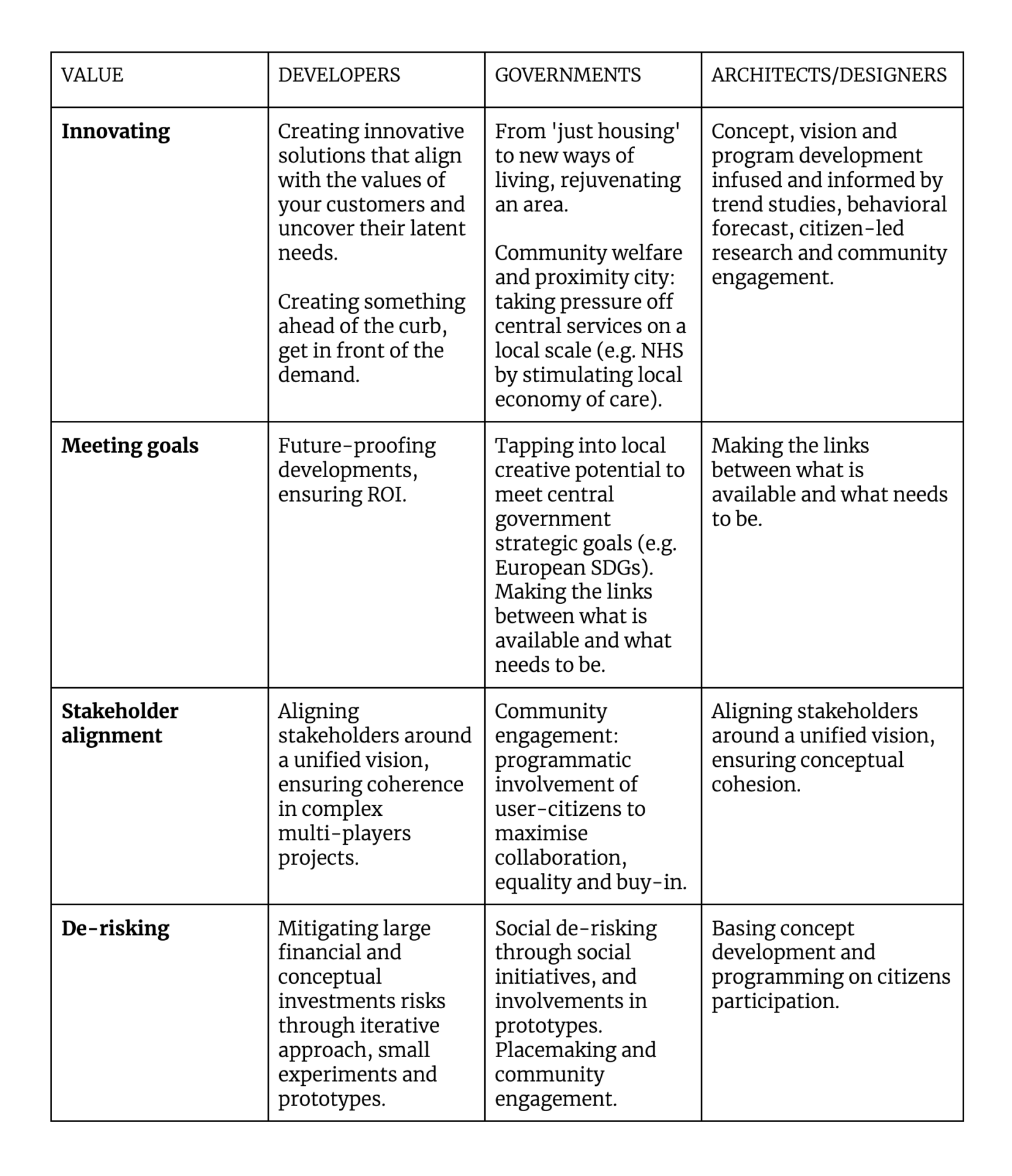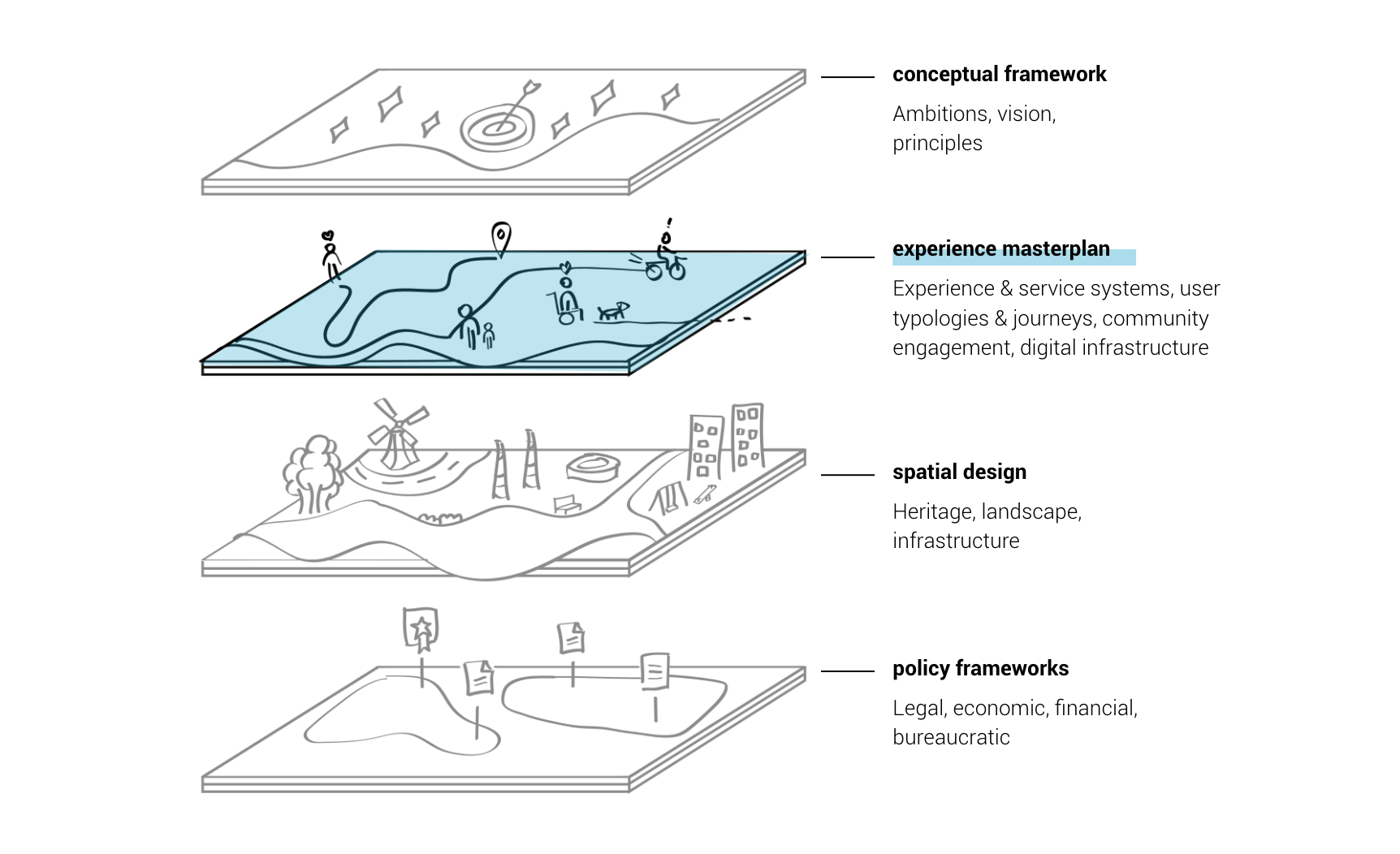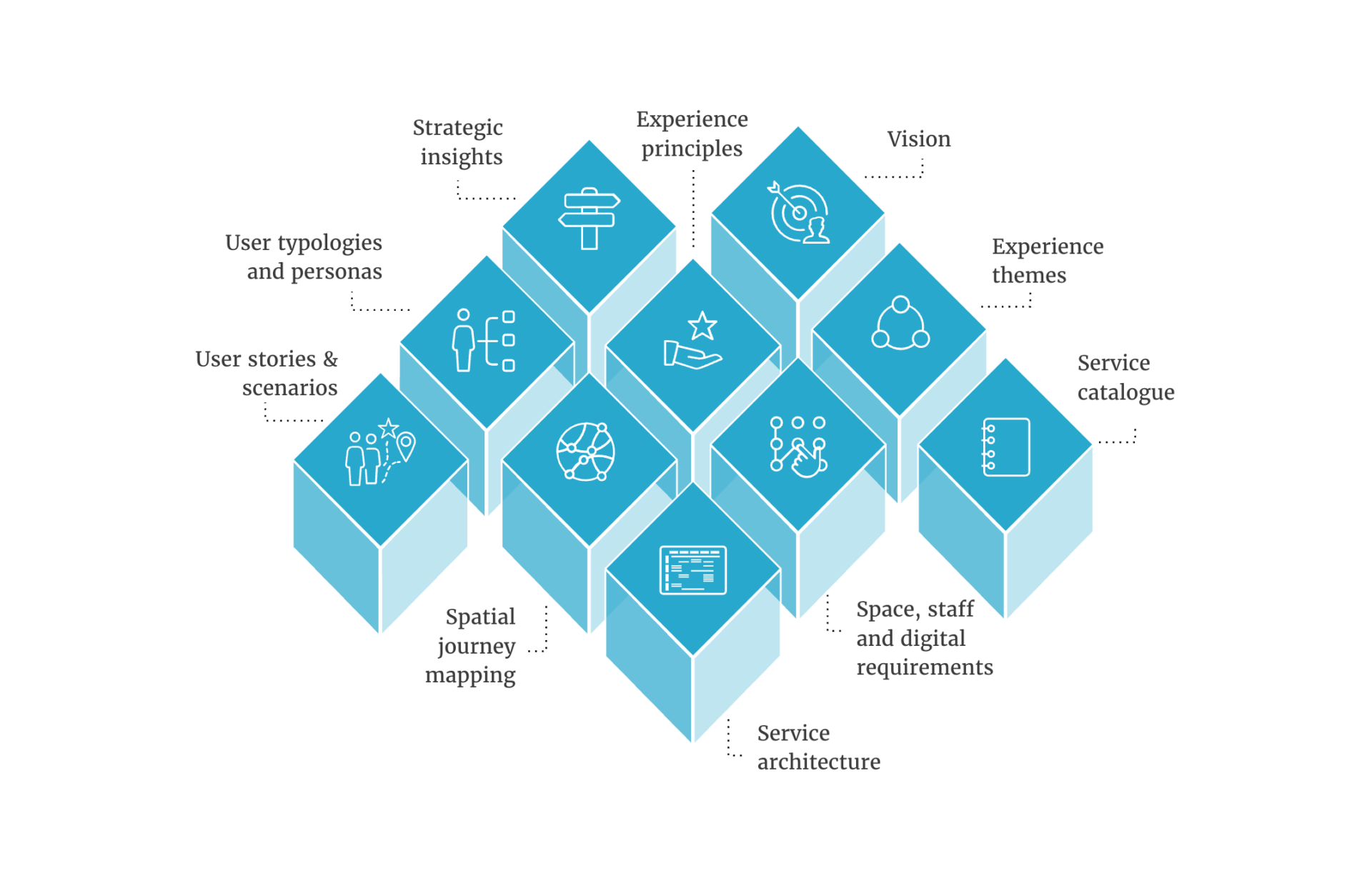Service design for urban development: value for stakeholders
At Livework we aim to design innovative urban realities that enable citizens to live sustainably, contributing to create a thriving, resilient environment for society.
Designing and planning for the future of cities implies the involvement of many crucial stakeholders: municipalities, developers, designers (architects, urbanists, landscape architects) and not least citizens. At Livework we take the perspective of citizens through collaborative research and co-creative design practices to develop solutions that tackle today and tomorrow’s urban challenges, while meeting the needs and expectations of all stakeholders.
Service design is great at:
“As far as service design is concerned, the human-centered approach and codesign and co-creation processes facilitate and enable the construction of consensus relationships and help to visualize (including through experimental prototypes) solutions, validate their effectiveness, and imagine their feasibility.”
- Beatrice Villar -Designing Sustainable Services for Cities: Adopting a Systemic Perspective in Service Design Experiments
Read Beatrice’s full study here.
What is the value of a service design approach to urban development for key stakeholders?
The ecosystem of actors involved in the (re) development of urban realities can greatly benefit from service design. Through the years we had the opportunity to take part in several collaborations, experiencing international and varied project contexts. We were hired by developers, governments and architects enabling us to understand their different yet interconnected challenges. Following is an analysis of things stakeholders benefited from when including a service design approach and a user-centered perspective in the design and development of urban projects.
 Map of key stakeholders involved in urban development projects.
Map of key stakeholders involved in urban development projects.

Developers
Especially now that uncertainty and volatility are defining factors of our future, developers face incredibly high risks when investing in urban development projects. The deployment of natural and financial resources that such developments imply is immense: developers and the planet cannot afford to waste it. It’s therefore imperative to make such investment worthwhile and ensure the future readiness of these urban projects.
But how can we anticipate what will be city dwellers’ spatial, relational and use needs for 100-120 years from now [1], today? How can today’s investments be still worth 100 years down the line? While one can never be completely certain about the future, a service design approach provides reliable tools to mitigate risks and proof concepts. First and foremost it enables the active involvement throughout the process of diverse expertises and citizens in a programmatic way, helping to anticipate future needs, values, constraints and desired behaviors influenced by environmental, economic, and socio-cultural transformations in place. This approach ignites the creation of a vision and innovative, sustainable solutions for an improved urban living experience based on the relevance of tomorrow’s urban needs.
Another benefit of this collaborative approach, in our experience, is that when developed in co-creation and well-illustrated, a vision proves to be a solid tool to anchor and harmonize stakeholders and reinforce coherence throughout the project effort. In 2021 we had the opportunity to work on an urban development project for an area of more than 20 hectares in Bangkok, a mixed-use development, including hospitality services, business and commercial area, cultural and semi-public spaces, a railway station and more. A multitude of stakeholders were involved, but the lack of a strong shared vision made it difficult to make decisions, coordinate efforts and create focus amongst the different players. Through on the ground, contextual research we were able to provide key ingredients for the formation of a vision for the experience of residents and visitors, as a sort of north star to simplify the decision making process.
Furthermore, core to a design thinking approach is its iterative and experimental nature, which can greatly benefit large and high-risk projects such as urban developments. Through a vast range of methods and tools, critical components of a project can be tested in a low-cost, low-effort way. From conceptualisation to implementation of solutions in the actual urban and social context, iteratively prototyping with the audience drastically minimizes risks of failures, increases chances of adoption and creates realistic expectations of results.
[1] The average time a building is programmed to last.
(Local) governments
While having to face challenges similar to developers, some of the toughest challenges local governments face in urban developments are of a wider, more systemic scale. Affordable housing, rising inequalities in accessing services, the search for adaptation strategies to counter climate change [3] are only a few of the intersectional issues that governments have to deal with in urban contexts. Balancing economic, social and environmental wellbeing is a complex task: addressing these multifaceted and complex challenges demands collaboration between governmental bodies, stakeholders, and communities to ensure inclusive, innovative and resilient urban solutions.
While no discipline can do it alone, service design offers a valuable framework for dealing with the wicked nature of these challenges. Being a practice rooted in design research and co-creativity, service design is equipped with tools that enable meaningful exchanges across different “languages”, means of communication across different fields of expertise, creating fertile ground for the generation of new living models across sectors, responsive to the particularity of local needs. The same approach also enables the generation of new links to connect existing resources and assets in support of these new models, making use of local assets and capabilities to create renewed dynamics. This can be useful for example in decreasing the pressure on central services supporting community welfare and an economy of care on a local scale. By understanding the needs and resources available within a specific community, local governments can sustain the emergence of essential services and amenities, enable proximity in the city, reducing reliance on centralized systems.
In the same manner, through community engagement and a programmatic involvement of citizens, local grass-root initiatives can be fostered. Facilitating placemaking, a service design approach can channel local creative potential to align with governmental challenges. By creating a shared space that uplifts citizens, local governments can ensure the effective deployment of funding in promising initiatives and build a more resilient urban fabric. Moreover, through rapid experimentation with low-cost, low-effort prototyping techniques, proposed solutions can be effectively tested, decreasing social, cultural risks . In summary, design thinking offers local governments a powerful approach to address the complex challenges of urban development. By employing this methodology, they can identify new living concepts, rejuvenate areas, decrease pressure on central services, utilize existing resources, tap into local creativity, and enhance community resilience, ultimately creating more sustainable and inclusive cities and communities.
Architects
Architects and urbanists are invested with the honorable yet difficult task to shape the future of our cities, proposing solutions to the multifaceted, complex problems they’re offered by their clients, be them private developers or public entities. While thoroughly trained in coming up with creative solutions to answer project challenges, we believe they too can benefit from including an outside-in, bottom-up approach in defining strategies and models within and beyond the physical design of urban developments. In our experience, insights derived from in-depth user research can result in the useful shaping of the overall conceptual direction and vision of a development, to establish design requirements and the definition of a strong program. Sharing the design process with local actors and experts can vehicle the emergence of innovative urban strategies, enabling the integration of cross-sector non-tangible solutions to the very tangible design of buildings and infrastructures. In fact, through the consideration in early stages of the service-systems (energy, mobility, finance, governance) that inevitably the design of new places embodies, and that citizens face in their day-to-day challenges, innovative and more systemic urban solutions can be found.
Architecture and urbanism firms too have to deal with managing large, high-risk investments and, as already mentioned, service design is equipped to break down these risks in small iterative experiments. Through prototyping, visual storytelling and a systematic involvement of stakeholders (citizens, experts, clients, public bodies etc.), from the early phases of conceptualisation until implementation the social, economical and practical validity of the solutions proposed can be tested.
In summary, by embracing a facilitated outside-in, bottom-up approach, integrating citizen research and stakeholder involvement, architects and urbanists can too benefit from a service design approach for the creation of more innovative, sustainable, and effective urban solutions.
By embracing co-creative practices between stakeholders, promoting active participation from the bottom up, and applying rapid prototyping, we are convinced that developers, urbanists, and local governments can meet their goals and de-risking high investment projects while implementing innovative solutions. Service design is a great asset in the complex and wicked challenges that the future of cities present because it entails a holistic and transdisciplinary approach and integrates tangible and intangible solutions, catering to the creation of vibrant and responsive urban realities that truly resonate with the needs and desires of urban dwellers.
How does livework go about it? An experience masterplan.
Through the years of practice and involvement in urban development projects, Livework has developed and consolidated a service design-driven approach to tackle challenges presented in different urban contexts, globally, from a variety of clients. What we’re often asked, is to design a coherent experience across the new development, its direct surroundings and beyond, to design service strategies that embrace all actors and sectors involved in an urban regeneration plan. So through our tools and methodology, we take with all actors involved (clients, citizens, partners, experts, etc) a leap in the future. We co-design – that is collaboratively envision, visualize and set-up for implementation – life-like scenarios that from the perspective of end-users, be them visitors, residents, non-human populations or providers, offer a glimpse into the mechanisms of a desired urban context.
We do this by designing an experience masterplan, a collection of frameworks that set a foundational plan for all services and experiences, digital and physical, that bring an urban design to life through its use. An experience masterplan is meant to communicate and be designed in synergy with other ‘layers’ that add up to a complete urban masterplan, from the legislative and policy foundations, through the very tangible architecture, landscape and infrastructure design until the all-encompassing conceptual framework that binds it all together (i.e. vision, principles, etc).
 Layers of a city masterplan.
Layers of a city masterplan.
There are several layers that add up to an city masterplan.
An experience masterplan aims at connecting the usually predominant design of materiality of the city (buildings, infrastructures etc.) with the design of light-weight or even intangible and dynamic elements (in service design lingo touchpoints) that create purposeful connections amongst actors. The synergy between these two approaches create conditions for interactions and relationships that sponsor the emergence of new models for resilient and sustainable lifestyles. In this interpretation, the architecture functions as a hardware: a material ensemble of static components that enable the functioning of a new, apparently intangible and dynamic operating system. In other words, just like a stage needs a performance, a body needs a mind, a city needs people to bring it to life.
Deep-diving into an experience masterplan
 Experience masterplan overview.
Experience masterplan overview.
As mentioned earlier, an experience masterplan is a collection of frameworks that set a foundational plan for all services and experiences, digital and physical, that bring an urban design to life through its use. Following is a deep-dive into some of what we think are most interesting and characteristic building blocks of this approach.
User typologies
The user typologies allow us to keep an overview of the different types of users that will interact with the project site. By enriching those typologies with behavioral traits we obtain personas, which help to better understand and make decisions from the perspective of the key users.
User stories
We create user stories in order to bring the personas to life and better articulate what their wants and needs are through compelling storytelling. User stories are also helpful to bring concepts of the future vision to life.
Spatial journey mapping
By plotting the different user journeys onto a map we are able to identify potential frictions between journeys or opportunities to enhance the overall experience. We call this spatial journey mapping.
Service catalogue
In any given project, there will be a program mix consisting of many different services and/or experiences. A service catalogue helps provide a holistic view of these services and experiences.
Experience themes
If we group those services that are similar in nature, e.g. services that are offered to improve the working experience of users, then we can identify key experience themes. The experience themes help make tangible the connections between the experiences and the project vision.
Implications
The space, staff and digital implications building block makes explicit the advice and recommendations that emerge from the research and affects the other layers of the masterplan, particularly the spatial design.
Service architecture
Finally, a service architecture is an in depth view of how all the different experiences, services and concepts come together to respond to the user’s wants and needs. It is a living framework that provides structure and helps identify journeys that need improvements or further development over time.
Together these building blocks help develop and bring a vision for urban regeneration to life, while strengthening the alignment of the team involved, feeding the overall masterplan with relevant insights and helping to attract investors and partners through compelling narratives.
In conclusion, Livework’s objective is to design innovative urban realities that support sustainable living and contribute to the development of thriving and resilient communities. We recognize that designing and planning for the future of cities requires the participation of multiple stakeholders, including municipalities, developers, designers, and citizens. We do this through a service-design approach that we packaged into an experience masterplan, a collection of frameworks that in synergy with an urban masterplan enables conditions for new living models for resilient and sustainable urban realities.
Synopsis

With a background in product design, I’m a strategic designer that likes to work combining abstract thinking to the concreteness of tangible and elegant solutions.